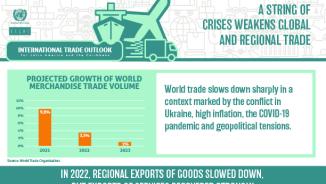News
The throughput of containerized cargo in the ports of Latin America and the Caribbean rose around 6.1% in 2017, according to data released today by ECLAC in its Maritime and Logistics Profile. This average figure points to a rebound versus the last three years, when low or negative growth rates in container throughput were recorded at a regional level.
According to the ranking published by the United Nations organization, this data confirms the improvement in Latin America and the Caribbean’s foreign trade in 2017 as well as the heterogeneity of growth rates in activity among the region’s ports.
The countries whose container port terminals contributed the most to the change in cargo volume versus the previous year are (from greatest to smallest, according to their relative change): the Dominican Republic (24.0%), Colombia (13.3%), Mexico (12.2%), Panama (10.1%) and Brazil (5.0%). They are followed by, with a smaller contribution to the rise in regional volume but notable relative changes in terms of individual performance: Honduras (9.8%), Peru (9.4%), Argentina (6.7%), Uruguay (5.8%), Chile (5.7%) and Ecuador (4.7%). Finally, those countries that also had a significant performance on an individual level, but marginal participation in the regional volume variation, are: Suriname (13.9%), Grenada (11.6%) and Nicaragua (9.5%).
The total volume of activity in 2017 reached approximately 50.6 million TEU (the standard unit of measurement, equivalent to a container of a length of 20 feet, or 6.25 meters, meaning it is a standard-sized metallic box that can be easily transferred between different modes of transportation, such as ships, trains and trucks). The first 40 ports in the ranking represent a little more than 87% (or 44.0 million TEU) of this type of cargo operations in the region (a similar percentage to the previous year). The 100 ports that follow move the remaining 13% (6.6 million TEU), the Economic Commission for Latin America and the Caribbean (ECLAC) indicates.
It adds that the region’s top 10 ports capture 48.2% of cargo in containers in an aggregate manner (a percentage slightly higher than that of the previous year, which was 47.4%). The change in the traffic handled at the top 10 was 7.9%, which was above the regional variation (in 2016, the variation was negative, at -4.0%).
According to ECLAC, container port traffic in 2017 also experienced a significant improvement on a global level, thanks to a rebound in international trade. According to estimates published by Alphaliner, the top 110 container ports in the world saw their volume rise 6.1% on average in 2017, meaning that in aggregate terms they reached 600 million TEU (compared with the 565 million TEU notched in 2016). Of these 110 ports, 98 saw gains in their volume while only 12 reported losses.
As in past editions of the ranking, the data compiled by ECLAC shows great heterogeneity in the behavior of port throughput, both at a subregional level as well as by country. In 2017, the East Coast of South America (ECSA) recorded increased activity at container terminals (5.3%), as measured by volume, which compensated for the decline seen in 2016 (-2.8%), thanks to what occurred, in relative terms, in the ports of Argentina, Brazil and Uruguay. Meanwhile, the West Coast (WCSA) continued on an upward trend since activity rose again (6.4%), beating the pace of the previous year (3.7%), due to the positive evolution of port terminals in Peru, Chile, Ecuador and Colombia.
Meanwhile, on both coasts of Central America (including Mexico) – the East Coast (ECCA) and West Coast (WCCA) – container traffic experienced positive growth (12.6% on the ECCA and 4.8% on the WCCA), which reversed what occurred in 2016 (when the declines were -1.2% and -1.3%, respectively). In the ECCA, there were notably higher levels of activity in the ports of Panama, Mexico and Honduras, while in the WCCA, greater port activity was seen in Mexico, Costa Rica, Nicaragua and Honduras.
Finally, in the Caribbean and on the North Coast of South America (NCSA), container throughput in port terminals was dissimilar. On the one hand, in the Caribbean it fell again (-1.1% versus -2.5% in 2016), whereas on the NCSA a significant improvement was seen in comparison with 2016 (11.4% versus just 0.4% growth in 2016). In the Caribbean, the rise in container traffic was notable in the ports of the Dominican Republic, Grenada and, to a lesser extent, Antigua and Barbuda and Martinique, while on the NCSA the most marked increases were seen in Colombia and Suriname.
More information:



